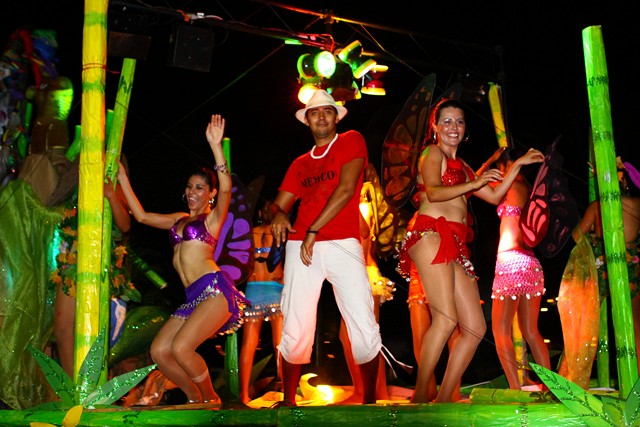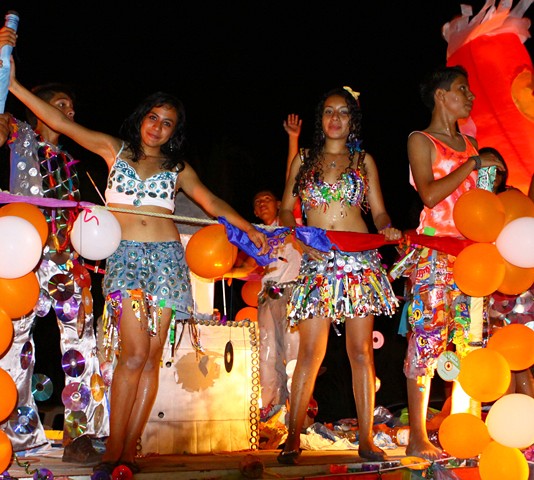

 Carnaval is fun, the idea is to participate: Get a costume, get crazy, be
happy and dance in the streets. After all, Carnaval only comes once a year
and anything goes!
Carnaval is fun, the idea is to participate: Get a costume, get crazy, be
happy and dance in the streets. After all, Carnaval only comes once a year
and anything goes!
CARNIVAL, OR CARNAVAL, as it is called in Latin America, comes from the Latin meaning "farewell to the flesh." It refers to the 40 days of Lent, when Christians were forbidden to eat meat, had to wear somber clothing and refrain from merriment.
So the days preceding Lent were the last opportunity to enjoy the pleasures of the flesh and Carnaval evolved as a period of sanctioned excess, of carefree abandon and indulgence in which wild behavior was accepted as a necessary outlet.
The familiar colorful trappings of Carnival, with its wild costumes, masked balls and parades, probably originated in Venice in the 12th Century. But the use of masks and other disguises probably has roots in ancient pagan times when they were used for protection against evil at inauspicious times when malevolent spirits were thought to be about.
The spectacular samba parades and lavish costumes of Rio are the benchmark for Carnaval, but local variations take place throughout Latin America. In Mexico, the tradition is strongest in Merida, Veracruz, Mazatlan and Cancún. Here in Puerto Escondido, Carnaval was revived by the state government some years ago to help give a boost to regional tourism. Many schools, colleges and community groups, including Puerto's gay community, have embraced this celebration, but it hasn't quite taken hold here. Most people just stand about and watch the parades, instead of participating.
But north of here Carnaval is a strong and vibrant tradition, deeply rooted in the Afro-Mestizo and Mixtec communities of the Costa Chica ("Small Coast", which extends from Rio Verde into the state of Guerrero, beyond San Marcos).
 In villages such as San Juan Colorado and Santa María Huazolotitlan,
everybody gathers during the days of Carnaval to watch traditional masked
dances such as The Badger's Dance, the Jawbone Dance among other.
All of these dances are very satirical in nature, breaking social and sexual
taboos and taking shots at the status quo; even the local authorities and
village elders have to put up with taunting and teasing without complaint.
The pantomime aspects and themes of these dances might seem naive, but they
are very meaningful to the locals, because they often allude to rumors and
gossip about neighbors, exposing peccadillos and even naming people who may
have committed crimes.
In villages such as San Juan Colorado and Santa María Huazolotitlan,
everybody gathers during the days of Carnaval to watch traditional masked
dances such as The Badger's Dance, the Jawbone Dance among other.
All of these dances are very satirical in nature, breaking social and sexual
taboos and taking shots at the status quo; even the local authorities and
village elders have to put up with taunting and teasing without complaint.
The pantomime aspects and themes of these dances might seem naive, but they
are very meaningful to the locals, because they often allude to rumors and
gossip about neighbors, exposing peccadillos and even naming people who may
have committed crimes.
Many of the region's traditional dances share common characteristics. One is that only men dance, even when there are female characters, and the appearance of two characters, a couple, Pancho and Minga. Even though their origins, characteristics or names may differ, they always appear as a rich cattle rancher and his flirtatious wife. The dances also often involve cattle rustling and the hunt to find the evildoers.
In Pinotepa de Don Luis, Mixtec is heard much more often than Spanish. It is during Carnaval that the most elaborate dances are performed: the Dove Dance, the Tiger Dance and especially the Badger Dance.
For Carnaval in San Juan Colorado, the Old Badgers' Dance is performed. Music is provided by two violinists, a guitarist and two drummers.
Santa Maria Huazolotitlán is best known for its Dance of the Little Masks. It is thought to date back to the French invasion. When the French were driven out, the Indians celebrated by staging a grotesque caricature of the French, ridiculing the way they danced, their behavior and appearance. This parody, with its pink-faced masks, became a regional tradition. It's known as The Jawbone dance in San Juan Colorado and Dance of the Dandy in Jamiltepec.
These vibrant indigenous communities have conserved their identity and
cultural heritage through these dances and through the ancient techniques of
their arts and crafts. But, given the onslaught of global mass culture,
these traditions are under attack; Many of the older people still wear
traditional dress, but few of the young can be seen in huipil and pozahuanco.
Now is the time to experience these places.